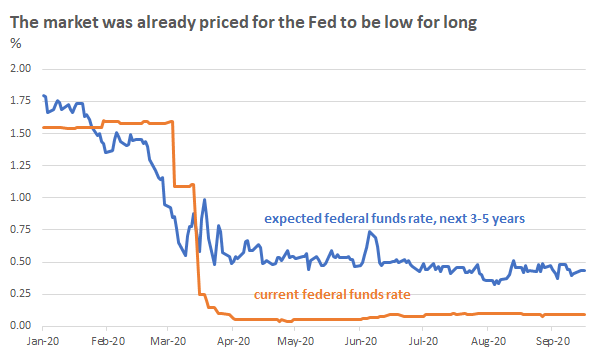September Fed meeting: The (long) wait for 2% inflation begins
Economists were focused on three facets of the U.S. Federal Reserve (the Fed)’s meeting today. Importantly, none of these three outcomes were particularly consequential for investors.
1. New forward guidance
Would the Fed clarify its forward guidance on interest rates following Powell’s announcement at the annual Jackson Hole, Wyoming, economic symposium about the transition to a new average inflation targeting (AIT) framework?
As a reminder, AIT is basically a commitment to keep interest rates lower for longer, allowing inflation to overshoot the 2% objective for a time to compensate for undershoots that normally occur during recessions and the early years of an economic recovery. The Fed did enhance its forward guidance today, committing to keep interest rates at zero until the U.S. economy reaches full employment and “inflation has risen to 2 percent and is on track to moderately exceed 2 percent for some time.”
Put differently, the Fed has pinned liftoff to an economic outcome, namely that inflation must hit its 2% objective and be expected to exceed it for some time. No major surprises here, although some economists did not think the Fed would be able to agree on this new language until the November meeting.
2. Interest rate forecasts for 2023
Would the Fed show any rate hikes in its updated forecasts, which now include the central bank’s expectations for 2023 for the first time?
13 out of the 17 Federal Open Market Committee (FOMC) participants penciled the federal funds rate to remain at the zero bound through the end of 2023 under their baseline outlook. While this is a dovish statement on the surface, it will not have been very surprising to professional investors given fixed income markets were already priced to the floor with only one quarter-point rate hike expected from the Fed over the next five years (chart). This pricing did not move much in the 30 minutes around the announcement.
Click image to enlarge
Source: Thomson Reuters Datastream, Russell Investments calculations as of 11:30 a.m. Pacific time on September 16, 2020.
3. Asset purchases
Would the Fed change the average maturity of its asset purchases to focus more on longer-term bonds?
The Federal Reserve’s quantitative easing (QE) program to-date has bought Treasury securities across the Treasury curve. There is a view in the market—with short-term rates already glued to the floor—that the Fed could get more bang for the buck in terms of easing financial conditions by purchasing more duration from the market. Chair Jerome Powell did not go there today.
If we were to try to unpack why the FOMC did not do so, it is probably because they see too much uncertainty in the economic outlook from the virus to be that precise OR that they view the prevailing level of long-term rates as already being sufficiently accommodative.
Rate and market outlook
The path forward largely hinges on the medium-term outlook for U.S. inflation. As we’ve written about, inflationary pressures are normally a consequence of an economy having more aggregate demand for goods and services than its productive capacity can handle. Given COVID-19 drove a recession and a shortfall in aggregate demand, we do not see upside risks to inflation as being a major concern for at least the next one to two years.
Put differently, there is still a hole for the economy to climb out of before the output gap (economist lingo) closes. In our most bullish scenario for the economy (reflecting on the historic levels of fiscal stimulus, the natural disaster nature of the COVID-19 shock, and the better-than-expected economic news in recent months), we see rate hikes as being possible in late 2022. However, our central tendency is similar to the Fed’s, with it being much more likely that the central bank remains on hold through 2023 before inflationary pressures start showing an overshoot.
Zooming in on the next 12 months in particular, we think the Fed is all but certain to hold interest rates near zero and, contingent on positive vaccine news, we see potential for the 10-year Treasury yield to rise modestly to 1%—resulting in a modest steepening of the yield curve. If this view is correct, it could contribute to a rotation from longer-duration growth stocks to shorter-duration value stocks.
